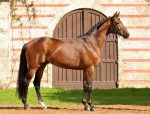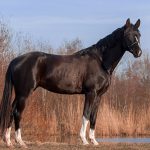Trakehner Horse
The Trakehner Horse is a breed of German horses that initially developed in the region of Prussia. It has a long war history, and could eventually manage to withstand the crises by its adaptability and inborn hardiness. It is one of the most common show horses found in Germany.
Trakehner Horse Pictures
- Chestnut Trakehner
- Grey Trakehner
- Trakehner Dressage
- Trakehner Foal
- Trakehner Horse Breed
- Trakehner Horse Jumping
- Trakehner Horse
- Trakehner Horses
- Trakehner Jump
- Trakehner Mare
- Trakehner Pictures
- Trakehner Stallions
- Trakehner
- Trakehners
Quick Information
| Official Name | The East Prussian Warmblood Horse of Trakehner Origin |
| Behavioral Characteristics | Intelligent, anxious, accepting, alert, keen, stable |
| Physical Traits | Slim and stout structure with a refined and elegant head, large and expressive eyes, a long neck ending in a straight, short back and a deep chest; the legs are muscular with broad joints and solid hooves |
| Coat Colors | Any color (bay, gray, chestnut and black are most common); some roan and tobiano pinto specimens also found |
| Height/Size | Up to 17 hands (adult) |
| Weight | 1200 pounds (adult males and females) |
| Common Uses | Riding, sports, light draft, eventing, shows |
| Health Problems | Subjected to relatively more health issues than other breeds, including colic, cribbing, laminitis, and weaving |
| Type | Sports Horse, Show Horse, Riding horse |
| Blood Type | Warm |
| Ancestors (Bloodlines) | Arabian, Thoroughbred, Turkmenistan, Lithuanian, Thoroughbred, Mecklenburg, Danish, and Turkish |
| Popular Traits | Intelligent, even-tempered, energetic, kind |
| Feeding/Diet | General horse diet including hay, grass, grains, etc. |
| Country of Origin | Germany |
| Time of Origin | 1732 |
| Associations, Registries & Other information | American Trakehner Association |
Video: Trakehner Horse Show & Training
History and Development
Some experts believe that this breed originated in the 5th and 6th centuries BC with the effort of the Scythians rulers, from a local race called ‘Schweiken’ that is now extinct. However, in the latter decades, their blood was infused with different other Mongolian and Turk strains.
In 1732, the King of Prussia took further efforts by selective breeding using animals from the royal stud, and finally moving the new animals to his new breeding stud in Trakehen. Thoroughbred, Arabian and Turk blood were also introduced to these equines so as to create a robust cavalry for the purpose of war.
As the king passed away in 1787, the horses were transferred to a breeding stud run by the state to further improve the stock by adding the Turkish, Thoroughbred, Mecklenburg, Lithuanian, and Danish genes.
In 1878, an official studbook for these horses was established, and the breed remained popular until the early 20th century before the World War II ruined the stock, while the finest animals were carried away by the Russian forces. Fortunately, those that survived could eventually withstand the hard times and survived to procreate the next generation of Trakehners.
In 1947, the government established the West German Association of Breeders of the Trakehner, while in 1950, they got an official status. Presently, after much effort, the population of this breed has come up to a safe level.

















